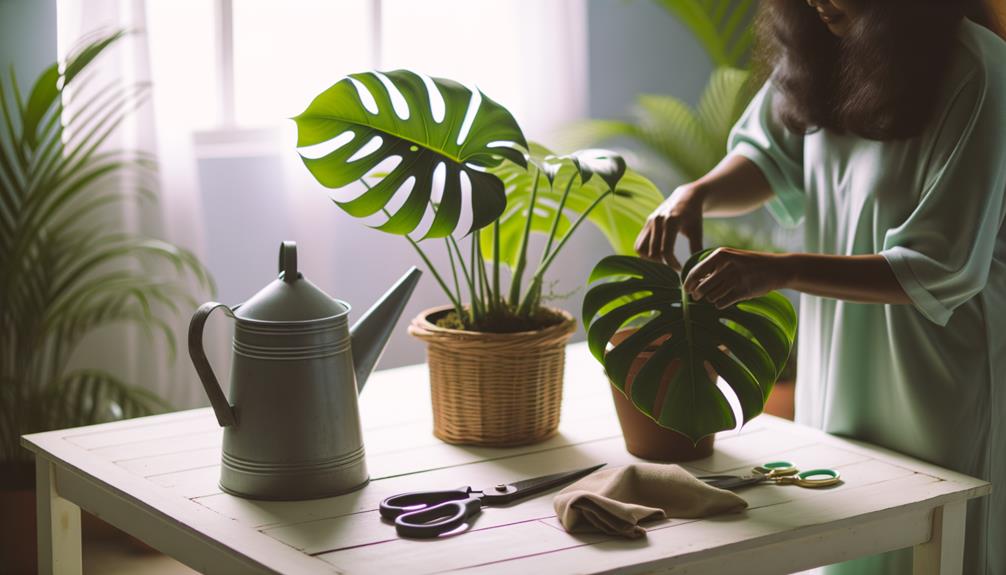How to Keep Monstera Deliciosa Small
To maintain your Monstera deliciosa small, utilize sterilized pruning shears to trim back older, yellowing leaves and prune aerial roots towards the main stem. Offer indirect, filtered light, preferably in east or north-facing rooms.
Maintain the soil slightly acidic and well-draining, watering only when the top 2-3 inches are dry. Utilize a pot with good drainage that limits root growth, and repot every 2-3 years.
Apply a diluted 20-20-20 NPK fertilizer every 4-6 weeks. Monitor new growth weekly, and trim large leaves and roots as necessary.
There are several more tips to ensure ideal size management.

Key Takeaways
- Regularly prune older leaves and aerial roots using sterilized pruning shears to control size.
- Provide indirect, filtered light to prevent excessive leaf growth.
- Water only when the top 2-3 inches of soil are dry to avoid overwatering.
- Use a well-draining potting mix and a pot with restricted root growth.
- Apply diluted balanced fertilizer every 4-6 weeks to maintain controlled growth.
Pruning Techniques
To keep your Monstera deliciosa small, begin by systematically pruning its aerial roots and older leaves with sterilized pruning shears. First, disinfect your shears with isopropyl alcohol to prevent pathogen transmission.
Target older, yellowing leaves and cut close to the stem, ensuring a clean, angled cut. For aerial roots, trim them back to the main stem, avoiding damage to the plant's vascular tissue.
Always prune during the plant's active growth phase, typically spring or early summer, to promote quicker recovery. Monitor for signs of stress, such as wilting or browning, and adjust your pruning frequency accordingly.
Consistent, careful pruning will help maintain a manageable size and encourage a more compact, bushy appearance for your Monstera deliciosa.
Controlled Light Exposure
Ensuring controlled light exposure is essential for keeping your Monstera deliciosa small and manageable. You should provide indirect, filtered light to limit the plant's growth. Direct sunlight can cause excessive growth and leaf burn in Monstera deliciosa. Aim for placement in a room with east or north-facing windows. Use sheer curtains to diffuse the light if needed.
Here's a quick reference table for ideal light conditions:
| Light Source | Duration (Hours) | Intensity (Lux) |
|---|---|---|
| Indirect Sunlight | 6-8 | 10,000 – 20,000 |
| Fluorescent Bulbs | 8-10 | 5,000 – 10,000 |
| LED Grow Lights | 10-12 | 10,000 – 15,000 |
| East-facing Window | 6-8 | 8,000 – 15,000 |
| North-facing Window | 8-10 | 6,000 – 12,000 |
Adjust lighting based on your plant's response to maintain its compact size.
Proper Watering
In addition to managing light exposure, maintaining proper watering practices is essential for keeping your Monstera deliciosa small and healthy. Overwatering or underwatering can lead to root rot or dehydration, respectively.
To ensure peak hydration, follow these detailed guidelines:
- Watering Frequency: Allow the top 2-3 inches of soil to dry out before watering again. This typically means watering every 1-2 weeks, depending on humidity and temperature.
- Water Quality: Use room-temperature, filtered water to prevent chlorine and fluoride from damaging the roots.
- Drainage: Ensure your pot has drainage holes to prevent water from accumulating at the bottom, which can suffocate the roots.
Soil and Pot Choice
Selecting the appropriate soil and pot is crucial for controlling the growth of your Monstera deliciosa. Use a well-draining potting mix containing peat, perlite, and pine bark to prevent root rot and over-expansion.
Monstera deliciosa prefers slightly acidic to neutral pH, around 5.5 to 7. Opt for a pot with adequate drainage holes to avoid waterlogging. Choose a container that restricts root growth; a pot 1-2 inches larger than the root ball works best. Terracotta pots can help draw away excess moisture, further regulating growth.
Repotting every 2-3 years will also aid in managing size, as it limits the roots' ability to spread. Always make sure the new pot isn't excessively larger than the old one to maintain control.
Fertilizer Use
To further manage the growth of your Monstera deliciosa, applying a balanced, water-soluble fertilizer every 4-6 weeks during the growing season is crucial. Choose a fertilizer with a nitrogen-phosphorus-potassium (NPK) ratio of 20-20-20 to guarantee balanced nutrient provision. Dilute the fertilizer to half the recommended strength to avoid overfeeding, which can stimulate excessive growth.
When fertilizing, ensure even distribution by thoroughly mixing the solution into the water before applying it to the soil. Avoid direct contact with the leaves to prevent burn.
Proper fertilization helps manage Monstera's size effectively.
- Nutrient Absorption: Enhanced uptake of essential nutrients.
- Controlled Growth: Prevents overgrowth by managing nutrient levels.
- Root Health: Promotes healthy root development, aiding in size management.
Training and Staking
Proper training and staking of Monstera deliciosa are essential to manage its growth and maintain a compact form.
First, select a sturdy moss pole or bamboo stake, ensuring it's tall enough to support the plant's mature height. Insert the stake into the pot, close to the plant's base. Use soft plant ties to secure the main stem to the stake, allowing for natural growth without constriction.
As Monstera deliciosa (commonly known as the Swiss cheese plant) grows, continually adjust ties to provide support. Regularly prune any aerial roots that extend beyond the stake to prevent unwanted spread.
This method will encourage vertical growth, helping you maintain a smaller, more manageable plant.
Temperature and Humidity
Maintaining the ideal temperature and humidity levels is crucial for Monstera deliciosa's health and controlled growth. Aim to keep the temperature between 65-75°F (18-24°C). Temperatures below 50°F (10°C) can stunt growth and cause damage.
Monitor humidity closely, as Monstera deliciosa thrives in 60-80% humidity. If your indoor environment is dry, consider:
- Humidifiers: These devices can sustain appropriate humidity levels.
- Pebble trays: Place a tray filled with water and pebbles under the plant pot.
- Misting: Regularly sprinkle the leaves using distilled water.
Avoid placing your plant near HVAC vents or drafty windows, as inconsistent temperatures and airflow can stress the plant.
Pest Management
To manage pests on your Monstera deliciosa, identify common culprits like spider mites (Tetranychus urticae) and scale insects (Coccoidea).
Employ natural pest control methods such as neem oil (Azadirachta indica extract) or insecticidal soap.
Regularly inspect the plant for early signs of infestation to maintain its health and size.
Common Monstera Pests
Monstera deliciosa, like many houseplants, often falls prey to pests such as spider mites (Tetranychus urticae), scale insects (Coccoidea), and mealybugs (Pseudococcidae), which can cause significant damage if not addressed promptly. You'll need to regularly inspect your plant for these common pests to maintain its health.
- Spider mites (Tetranychus urticae): Look for fine webbing and tiny, moving dots on the leaves.
- Scale insects (Coccoidea): Check for small, oval, brown or black bumps on stems and undersides of leaves.
- Mealybugs (Pseudococcidae): Identify white, cotton-like masses mainly in leaf axils and stem joints.
Natural Pest Control
Addressing these pests effectively often demands natural pest control methods, which are safer for both you and your Monstera deliciosa. To combat aphids (Aphidoidea), regularly spray a neem oil solution (Azadirachta indica) onto affected leaves.
For spider mites (Tetranychidae), increase humidity by misting and introduce beneficial predatory mites like Phytoseiulus persimilis.
Treat scale insects (Coccoidea) by dabbing them with a cotton swab soaked in isopropyl alcohol. Ensure thorough inspection by checking the undersides of leaves and along stems.
Beneficial insects such as ladybugs (Coccinellidae) can also be introduced to control pests naturally. Consistent monitoring and early intervention are essential for maintaining pest-free plants while keeping your Monstera deliciosa healthy and small.
Regular Monitoring
Regularly monitor your Monstera deliciosa by inspecting for new growth. This includes checking for emerging leaves and stems. Assess the leaf size to guarantee it remains proportionate to your desired plant size, trimming as necessary.
Additionally, observe root development by examining the root ball. This helps prevent overcrowding and promotes healthy growth.
Inspect for New Growth
To monitor your Monstera deliciosa and ensure it remains compact, closely observe for new growth by examining each junction and space between leaves and stems weekly. Focus on any emerging shoots, as these will indicate where the plant is expanding. Use sterilized pruning shears to trim new growth if you wish to control its size.
- Junctions: Check for new buds forming at the connections of leaves and stems.
- Spaces between leaves and stems: Measure the distance to ensure distances remain short, indicating restrained growth.
- Aerial roots: Observe any new aerial roots; removing these can also limit the plant's size.
Check Leaf Size
Monitor the leaf size of your Monstera deliciosa by measuring the width and length of each leaf every week, as oversized leaves can indicate the plant is outgrowing its intended space. Use a ruler or measuring tape for consistency. Record the dimensions to track growth trends.
Large leaves, particularly those exceeding 30 cm in width, can signal the need for intervention. Maintain smaller foliage by limiting light exposure; place the plant in moderate, indirect sunlight. Prune leaves that are disproportionately large using sterilized pruning shears. This will direct the plant's energy towards maintaining a compact size.
Regular monitoring helps assure that your Monstera deliciosa remains manageable and aesthetically pleasing within your desired space.
Observe Root Development
Consistent evaluation of the root system of Monstera deliciosa is essential for ensuring the plant remains within the desired size constraints. Regularly monitor the roots by gently removing the plant from its pot every few months. Look for signs of overgrowth, which can lead to increased foliage and size.
- Root Pruning: Trim back roots using sterilized pruning shears to control growth.
- Pot Size: Use smaller pots to naturally restrict root expansion and plant size.
- Repotting Frequency: Repot less frequently to limit root development and overall plant growth.
Conclusion
By following these strategies, you'll maintain your Monstera deliciosa in a more manageable form.
Prune regularly to encourage compact growth, and keep light exposure controlled to prevent leggy stems.
Water judiciously, avoiding both parched and swampy conditions.
Choose a snug pot and well-draining soil to limit expansion.
A light hand with fertilizer will do wonders.
Train and stake as needed, and keep an eye on temperature, humidity, and pests.
With attentive care, your Monstera will remain a well-behaved housemate.






